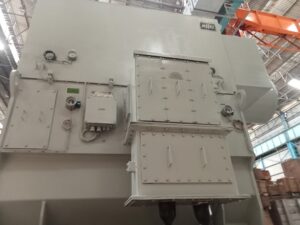The Efficiency of a Three Phase Induction Motor is a crucial parameter that measures how effectively the motor converts electrical energy into mechanical energy, thus indicating its overall performance and energy utilization.

Efficiency (η) is defined as the ratio of the output power (useful mechanical power) to the input power (electrical power supplied to the motor) and is usually expressed as a percentage:
Efficiency (η) = (Output Power / Input Power) × 100%
Now, let’s break down the components that contribute to the efficiency of a three-phase induction motor:
1. Input Power (Pin): Input power is the electrical power supplied to the motor. It comprises two main components:
a. Stator Input Power (Pstator): This is the electrical power drawn by the stator winding to generate the magnetic field necessary for motor operation. It is proportional to the stator current and voltage.
b. Rotor Input Power (Protor): This component represents the power transferred to the rotor through electromagnetic induction. It contributes to overcoming the mechanical load.
2. Output Power (Pout): Output power is the useful mechanical power produced by the motor’s shaft. It’s the power that contributes to doing the actual work. It can be calculated using the formula:
Pout = Torque × Angular Speed
Where torque is the twisting force generated by the motor and angular speed is the rotational speed of the motor in radians per second.
3. Copper Losses (Pc): Copper losses occur in the stator and rotor windings due to the resistance of the wires. These losses cause power dissipation in the form of heat.
4. Iron Losses (Pi): Iron losses, also known as core losses, occur due to the alternating magnetic flux in the motor’s core. These losses include hysteresis and eddy current losses.
5. Mechanical Losses (Pm): Mechanical losses include friction and windage losses due to bearings, air resistance, and other factors.
Given these components, the efficiency of a three-phase induction motor can be expressed as:
Efficiency (η) = (Pout / Pin) × 100%
Efficiency Calculation Example: Let’s consider a scenario where a three-phase induction motor has an output power (Pout) of 90 kW, stator input power (Pstator) of 100 kW, rotor input power (Protor) of 10 kW, copper losses (Pc) of 5 kW, iron losses (Pi) of 3 kW, and mechanical losses (Pm) of 2 kW.
Total input power (Pin) = Pstator + Protor = 100 kW + 10 kW = 110 kW
Total losses (Pl) = Pc + Pi + Pm = 5 kW + 3 kW + 2 kW = 10 kW
Efficiency (η) = (Pout / (Pin + Pl)) × 100% = (90 kW / (110 kW + 10 kW)) × 100% = (90 kW / 120 kW) × 100% = 75%
In this example, the efficiency of the three-phase induction motor is 75%.
To enhance the efficiency of three-phase induction motors, engineers focus on reducing copper losses through the use of better conductors and optimizing core design to minimize iron losses. Additionally, efficient control strategies and variable frequency drives (VFDs) can also contribute to improved motor efficiency across varying loads and speeds.
Thanks for reading the reading the article on Efficiency of Three Phase Induction Motor.